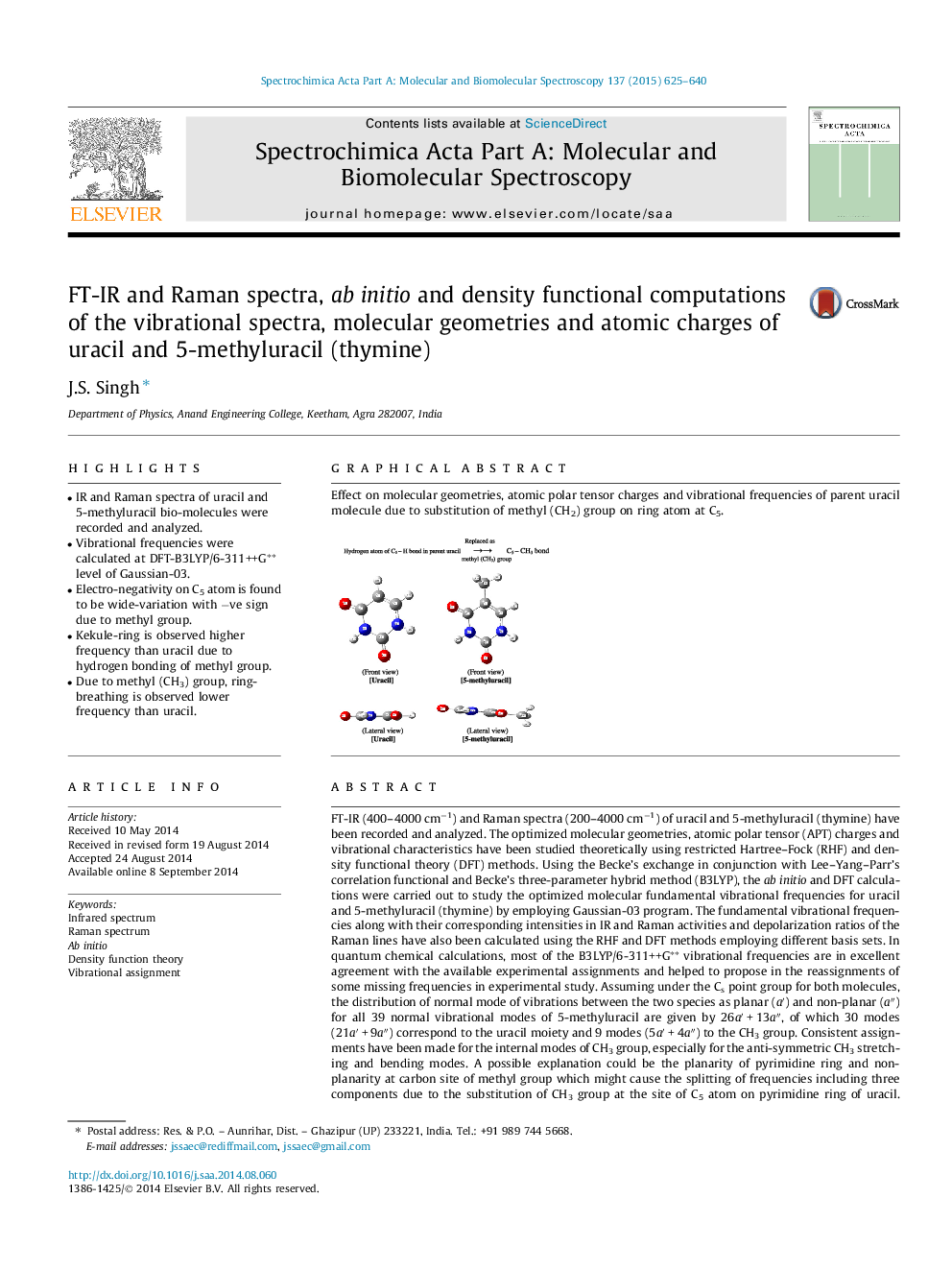| کد مقاله | کد نشریه | سال انتشار | مقاله انگلیسی | نسخه تمام متن |
|---|---|---|---|---|
| 1229286 | 1495232 | 2015 | 16 صفحه PDF | دانلود رایگان |

• IR and Raman spectra of uracil and 5-methyluracil bio-molecules were recorded and analyzed.
• Vibrational frequencies were calculated at DFT-B3LYP/6-311++G∗∗ level of Gaussian-03.
• Electro-negativity on C5 atom is found to be wide-variation with −ve sign due to methyl group.
• Kekule-ring is observed higher frequency than uracil due to hydrogen bonding of methyl group.
• Due to methyl (CH3) group, ring-breathing is observed lower frequency than uracil.
FT-IR (400–4000 cm−1) and Raman spectra (200–4000 cm−1) of uracil and 5-methyluracil (thymine) have been recorded and analyzed. The optimized molecular geometries, atomic polar tensor (APT) charges and vibrational characteristics have been studied theoretically using restricted Hartree–Fock (RHF) and density functional theory (DFT) methods. Using the Becke’s exchange in conjunction with Lee–Yang–Parr’s correlation functional and Becke’s three-parameter hybrid method (B3LYP), the ab initio and DFT calculations were carried out to study the optimized molecular fundamental vibrational frequencies for uracil and 5-methyluracil (thymine) by employing Gaussian-03 program. The fundamental vibrational frequencies along with their corresponding intensities in IR and Raman activities and depolarization ratios of the Raman lines have also been calculated using the RHF and DFT methods employing different basis sets. In quantum chemical calculations, most of the B3LYP/6-311++G∗∗ vibrational frequencies are in excellent agreement with the available experimental assignments and helped to propose in the reassignments of some missing frequencies in experimental study. Assuming under the Cs point group for both molecules, the distribution of normal mode of vibrations between the two species as planar (a′) and non-planar (a″) for all 39 normal vibrational modes of 5-methyluracil are given by 26a′ + 13a″, of which 30 modes (21a′ + 9a″) correspond to the uracil moiety and 9 modes (5a′ + 4a″) to the CH3 group. Consistent assignments have been made for the internal modes of CH3 group, especially for the anti-symmetric CH3 stretching and bending modes. A possible explanation could be the planarity of pyrimidine ring and non-planarity at carbon site of methyl group which might cause the splitting of frequencies including three components due to the substitution of CH3 group at the site of C5 atom on pyrimidine ring of uracil. The three non-equivalent CH bonds of CH3 group are distinctly separated from the CH/NH ring stretching frequencies. Kekule ring stretching mode is found to be comparatively higher frequency magnitude than the mode of uracil due to the involvement of hydrogen bonding of methyl group. But, the ring breathing is found to be lower frequency magnitude compared to those for uracil which could be due to mass effect of the CH3 group in place of the hydrogen atom at the site of C5 atom on pyrimidine ring of uracil.
Effect on molecular geometries, atomic polar tensor charges and vibrational frequencies of parent uracil molecule due to substitution of methyl (CH2) group on ring atom at C5.Figure optionsDownload as PowerPoint slide
Journal: Spectrochimica Acta Part A: Molecular and Biomolecular Spectroscopy - Volume 137, 25 February 2015, Pages 625–640